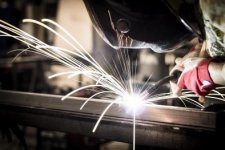Hi, I've been doing sheet metal fab for over 30 years now...it's what I built my business on, although I do much more work in bar and rod stock, and sculpture work now, Started out doing sheet metalwork in the roofing trade...learned on a some historical restoration jobs how to do it properly, and apprenticed for many years...lots of double locked standing seam roofs, box gutters, real custom and detailed flashing work, then moved into ornamental sheet work...cornices, custom bay window roofs and moldings, finial and weathervanes, cupolas...then started doing range hoods, countertops, front doors and bartops...you name it. Also didi some detail hvac work, but that's pretty basic stuff compared to the more demanding ornamental stuff.
Now with collapsible ducting, insulated fiberglas ductwork, and the fact that most standard sheet metal ductwork and fittings are available at the big box store I couldn't imagine wanting to try to compete with that. I would consider the ornamental detail aspects that I just described...much more satisfying, an much nicer high dollar niche, and essentially all the same tooling as an old style HVAC shop would use.
You would need a good sturdy 5' x 10' wood workbench and some shelves to store your sheet stock, a decent vice or two to hold tooling and stakes, an 18 ga soft steel shop brake and I would recommend a 4' maganabend or magnetic brake over a 4' finger/box brake. Hand tools like some decent hammers and mallets, snips and shears, hand tongs for deeper bends by hand...then some sheet metal forming stakes and a pexto bench plate to mount the stakes in...stuff like a blowhorn and beakhorn stake, coppersmiths stake, some round and dome head stakes etc. I'd also think about a set of electric handshears like the ones Draco makes...and maybe even a small diacro 24" shear. Other common and invaluable sheetmetal tools are rollformers like a 36" size at least, and a pexto rotary tool which can be very handy sometimes.
If you want to work on cars and do panel work then an english wheel is a very helpful tool, as are quality shrinker stretcher tools and some panel bags filled with sand. Also raising and sinking stumps are very helpful, and you can make those yourself
One thing I can't stress enough as an important set of tools for sheetmetal work are layout tools and good rules. Quality ornamental sheet metal layout can be very unforgiving, and compounded error adds up quickly during layout. It took me years to realize that the rulers I used were off...not me. Now it's only starrett rulers and straightedges...so something to consider from an old head at the game...
All this stuff can be found used from used machinery dealers...and none of it is so complicated that you can't find good quality tools in good shape. Buying a brake ain't nearly as complicated as buying something like a lathe...just a few simple checks and you can tell if it's a good tool or a beater...
You can make a great career learning ornamental sheet work. Believe me, there are not that many guys who are hammering out cool bowls, doing bartops and custom planters, sinks and doing it well. There's plenty of stuff available off the shelf...but theres also a really nice market of people who appreciate local handworked craftsmanship and art, and who need custom sized and creative solutions for applications where there's literally nothing available local, or even online. Here's just a fraction of some of the stuff I've done...just to show you what a nice market this work can be if you take some time to learns some skills and use some imagination
http://www.copperwork.com/sheetwork.html
Good luck if you go for it...




